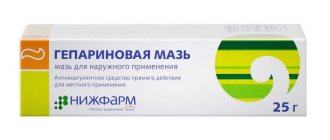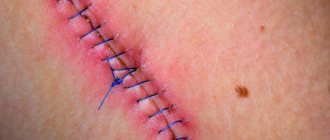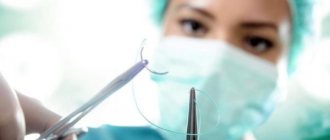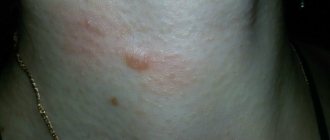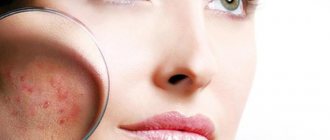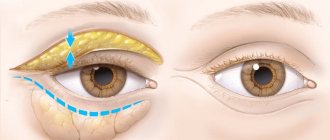Surgical intervention involving skin incisions does not pass without leaving a trace. Scars remain on the surface of the body. Some of them are small and unnoticeable, while others are large, bright, protruding above the surface of the skin.
It is completely impossible to remove scars after surgery, but it is quite possible to make them miniature and light. Modern cosmetology procedures will help with this.
Types of scars
Postoperative scars are a consequence of intensive growth of connective tissue in the area of skin damage. They can have different shades, sizes and shapes. The following types of scars after surgery are distinguished:
- Normotrophic. Does not protrude above the surface of the epidermis and does not differ from the skin in color.
- Atrophic. It looks like a small depression. Appears when there is insufficient amount of collagen.
- Hypertrophic. Protrudes above the surface of the skin and has a pink tint.
- Keloid. It has the shape of an elevation and a bluish tint. The skin in the affected area is tight, dry, and may peel. Often the patient is bothered by itching. Over time, keloid scars increase in size.
Scar removal after surgery is an optional procedure. If the scar is small, pale and located on an area of the body that can be easily hidden with clothing, you can refuse the procedure. If the scar causes discomfort and is noticeable to others, it is better not to wait, but to immediately contact a surgeon or cosmetologist.
Types of suture materials and suturing methods in modern medicine
An ideal suture material should have the following characteristics:
Be smooth and glide without causing additional damage. Be elastic, stretchable, without causing compression and tissue necrosis. Be durable and withstand loads. Tie securely in knots. Be biocompatible with body tissues, inert (do not cause tissue irritation), and have low allergenicity. The material should not swell from moisture. The period of destruction (biodegradation) of absorbable materials must coincide with the time of wound healing.
Different suture materials have different qualities. Some of them are advantages, others are disadvantages of the material. For example, smooth threads will be difficult to tighten into a strong knot, and the use of natural materials, so valued in other areas, is often associated with an increased risk of developing infection or allergies. Therefore, the search for the ideal material continues, and so far there are at least 30 thread options, the choice of which depends on specific needs.
Suture materials are divided into synthetic and natural, absorbable and non-absorbable. In addition, materials are manufactured consisting of one thread or several: monofilament or multifilament, twisted, braided, having various coatings.
Non-absorbable materials:
Natural – silk, cotton. Silk is a relatively durable material, thanks to its plasticity it ensures the reliability of knots. Silk is a conditionally non-absorbable material: over time, its strength decreases, and after about a year the material is absorbed. In addition, silk threads cause a pronounced immune response and can serve as a reservoir of infection in the wound. Cotton has low strength and is also capable of causing intense inflammatory reactions. Stainless steel threads are durable and produce minimal inflammatory reactions. Used in abdominal surgeries, when suturing the sternum and tendons. Synthetic non-absorbable materials have the best characteristics. They are more durable and their use causes minimal inflammation. Such threads are used for matching soft tissues, in cardiac and neurosurgery, and ophthalmology.
Absorbable materials:
Natural catgut. The disadvantages of the material include a pronounced tissue reaction, the risk of infection, insufficient strength, inconvenience in use, and the inability to predict the timing of resorption. Therefore, the material is currently practically not used. Synthetic absorbable materials. Made from degradable biopolymers. They are divided into mono and polyfilament. Much more reliable compared to catgut. They have certain resorption times, which differ for different materials, are quite durable, do not cause significant tissue reactions, and do not slip in the hands. Not used in neuro and cardiac surgery, ophthalmology, in situations where constant strength of sutures is required (for suturing tendons, coronary vessels).
Suture methods:
Ligature sutures - they are used to ligate vessels to ensure hemostasis. Primary sutures - allow you to compare the edges of the wound for healing by primary intention. Sutures can be continuous or interrupted. According to indications, immersed, purse-string and subcutaneous sutures can be applied. Secondary sutures - this method is used to strengthen primary sutures, to re-close a wound with a large number of granulations, in order to strengthen a wound that heals by secondary intention. Such sutures are called retention sutures and are used to unload the wound and reduce tissue tension. If the primary suture was applied in a continuous manner, interrupted sutures are used for the secondary suture, and vice versa.
Scars after surgery: what to do at home
A conservative approach is appropriate for small, fresh scars. In complex cases, treatment of scars after surgery involves the use of cosmetic procedures or surgical excision if other methods have not led to a positive result.
At home, you can use drugs with different pharmacological effects:
- accelerating regeneration;
- improving blood circulation;
- immunomodulatory.
It is possible to use ointments and gels containing enzymes to inhibit the rapid growth of new tissue or stimulate the synthesis of your own collagen. It is important to remember that scar correction after surgery is a long process. The drugs must be used for several months.
How long do stitches take to heal?
Every surgeon strives to achieve wound healing by primary intention. In this case, tissue restoration takes place in the shortest possible time, swelling is minimal, there is no suppuration, and the amount of discharge from the wound is insignificant. Scarring with this type of healing is minimal. The process goes through 3 phases:
Inflammatory reaction (first 5 days), when leukocytes and macrophages migrate to the wound area, destroying microbes, foreign particles, and destroyed cells. During this period, the connection of the tissues has not reached sufficient strength, and they are held together by seams. The phase of migration and proliferation (up to the 14th day), when fibroblasts produce collagen and fibrin in the wound. Thanks to this, granulation tissue is formed from the 5th day, and the strength of fixation of the wound edges increases. Phase of maturation and restructuring (from the 14th day until complete healing). During this phase, collagen synthesis and connective tissue formation continues. Gradually, a scar forms at the site of the wound.
How long does it take for stitches to be removed?
When the wound has healed to the point that it no longer requires the support of non-absorbable sutures, they are removed. The procedure is carried out under sterile conditions. At the first stage, the wound is treated with an antiseptic, and hydrogen peroxide is used to remove crusts. Grasping the thread with surgical tweezers, cross it at the point where it enters the skin. Gently pull the thread from the opposite side.
Suture removal time depending on their location:
Sutures on the skin of the torso and limbs should be left in place for 7 to 10 days. Stitches on the face and neck are removed after 2–5 days. Retention sutures are left in place for 2–6 weeks.
How to remove scars after surgery: modern cosmetic procedures
If there is a large scar left on the body after surgery, it is better to remove it using cosmetic procedures. Modern methods are safe and effective. There are several options for eliminating scars after surgery:
- Filling with collagen. A method recommended only for atrophic scars. It involves filling the depression with collagen and leveling the surface. The effect lasts for 12 months.
- Cryodestruction. The method involves treating the scar with liquid nitrogen. Damaged tissue is frozen and destroyed, and healthy skin grows in its place. The disadvantage of the method is pain, requiring anesthesia.
- Microwave therapy. The epidermis is exposed to electromagnetic waves, which allows you to achieve lasting results. In some cases, additional cryodestruction is required.
- Microdermabrasion. The surface of the epidermis is polished using chemical compounds - acids, powdered aluminum oxide. The downside is the ability to work only with small superficial scars.
- Dermabrasion. Another grinding option involves the use of special brushes. When carried out correctly, the procedure is safe, but violation of the technique can lead to the formation of new scars.
- Bukki-irradiation. The skin is treated with ultra-soft x-rays, which initiate the reverse development of the scar. The method is used for keloid and hypertrophic scars, but is prohibited in case of circulatory problems.
- Laser irradiation. The most common method recommended by doctors who tell how to get rid of scars after surgery. The method is suitable for different types of skin changes. Laser scar resurfacing is a quick procedure that is performed under local anesthesia.
Surgical intervention
In rare cases, when a scar causes significant discomfort, and a course of laser scar removal after surgery did not help, plastic surgery methods are resorted to. During the manipulation, the doctor excises the damaged tissue and transplants a skin flap of the patient taken from another area. The entire process takes about an hour and is performed under general anesthesia. Next begins the rehabilitation period, which may take several months.
Factors influencing the healing process
The speed of healing of sutures depends on many factors, which can be divided into several groups:
Features and nature of the wound. Definitely, wound healing after minor surgery will be faster than after laparotomy. The process of tissue restoration is lengthened in the case of suturing a wound after an injury, when there has been contamination, penetration of foreign bodies, and crushing of tissue. Location of the wound. Healing occurs best in areas with good blood supply, with a thin layer of subcutaneous fat. Factors determined by the nature and quality of surgical care provided. In this case, the features of the incision, the quality of intraoperative hemostasis (stopping bleeding), the type of suture materials used, the choice of suturing method, compliance with aseptic rules, and much more are important. Factors related to the patient’s age, weight, and health status. Tissue repair is faster at a young age and in people with normal body weight. Chronic diseases, in particular diabetes mellitus and other endocrine disorders, oncopathology, and vascular diseases, prolong the healing process and can provoke the development of complications. At risk are patients with foci of chronic infection, with reduced immunity, smokers, and HIV-infected people. Reasons related to caring for the postoperative wound and sutures, adherence to diet and drinking regimen, physical activity of the patient in the postoperative period, compliance with the surgeon’s recommendations, and taking medications.
Prevention
The main feature of a scar after abdominoplasty is constant tension. It is located in the abdominal area, which means the slightest movement affects its healing. Therefore, in the first month you will have to endure a lot of inconveniences: refuse any physical activity, ideally, stay in bed altogether. Do not lift any weights, do not eat foods that provoke fermentation. To avoid stretching the skin of the abdomen, you will have to change your usual sleeping position and fall asleep with your knees bent.
Experts recommend bed rest for the first 14 days, and to avoid bruises and swelling, be sure to use compression garments and silicone plates.
Under no circumstances should you touch the scar with your hands, especially in the first days after surgery. It is necessary to treat it with antiseptics and change dressings once a day - usually this happens on an outpatient basis, with a daily visit to a medical facility.



